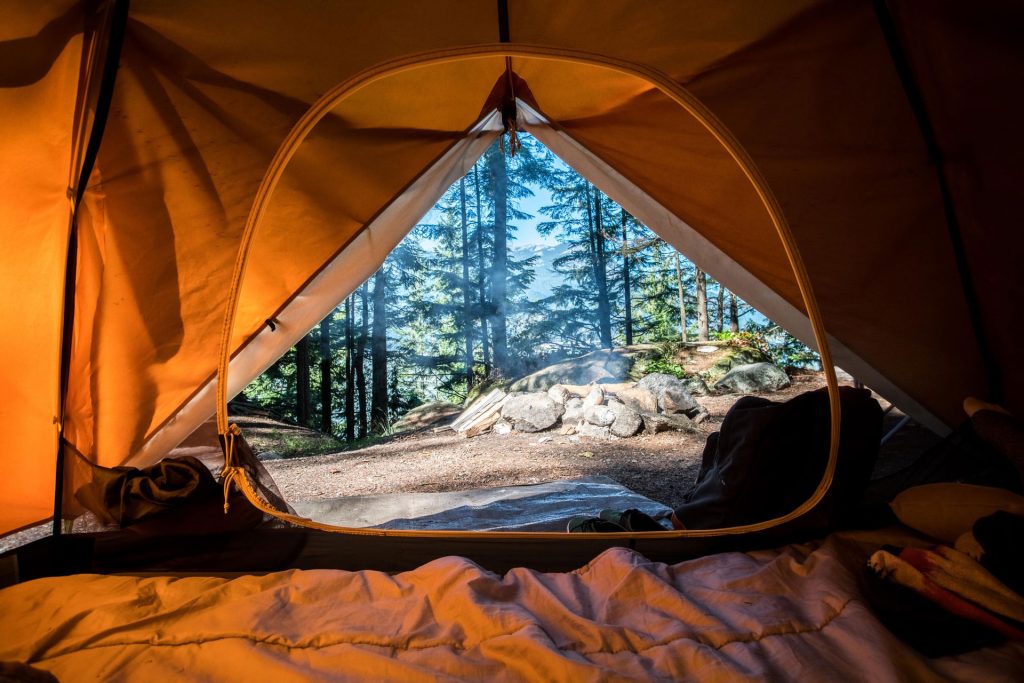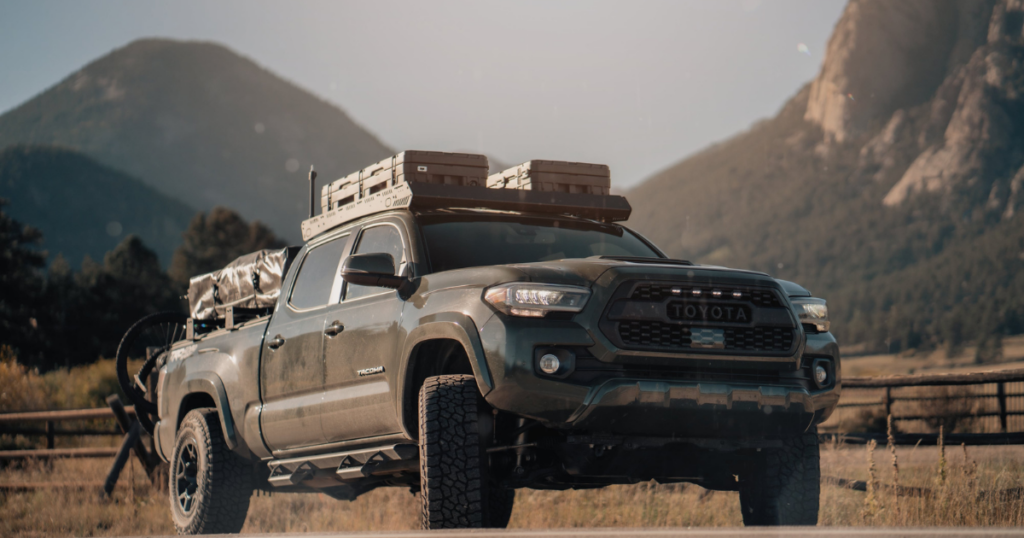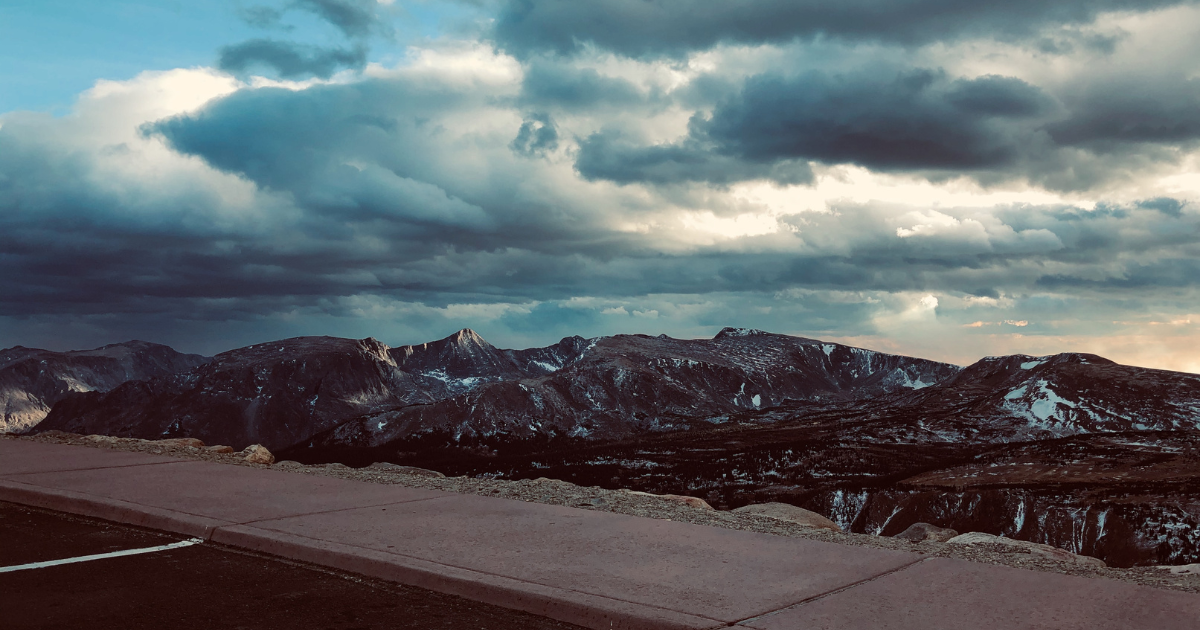Rocky Mountain National Park, Estes Park, UNited States
Everything You Need to Know
Rocky Mountain National PArk, Estes park, CO
Table of Contents
Snapshot of Rocky Mountain National Park
In 1915, President Woodrow Wilson set up the boundaries of the Rocky Mountain National Park by signing the Rocky Mountain National Park Act. More than 100 years later, RMNP stands as one of the most famous national parks in the US and the whole world.
The Rocky Mountain National Park is located in north-central Colorado and is a huge tourist attraction to wildlife lovers and outdoor enthusiasts. In this detailed article, you’ll learn everything you need to know about the history of this park, its most famous attractions, and the activities that attract all park goers. So keep on reading to learn more about this fantastic park and everything related to its past, present, and future.
It’s surrounded by the Roosevelt, the Routt, Arapaho national forests, and the Indian Peaks Wilderness area. The park contains 150 different lakes, more than 350 miles of trails, and rivers that extend for more than 450 miles.
RMNP is located about 76 miles away from Denver International Airport, making it a great destination for all outdoor enthusiasts. It’s located between Estes Park and Grand Lake, within the Front Range of the Rocky Mountains.
Rocky Mountain National Park contains some of the highest peaks and elevations in the US, with heights ranging from 7,860 to 14,259 feet. It also includes the highest paved through road in the US. RMNP is home to 60 mountains that peak over 12,000 feet, in addition to a number of thirteener peaks that appeal to mountain climbing lovers.
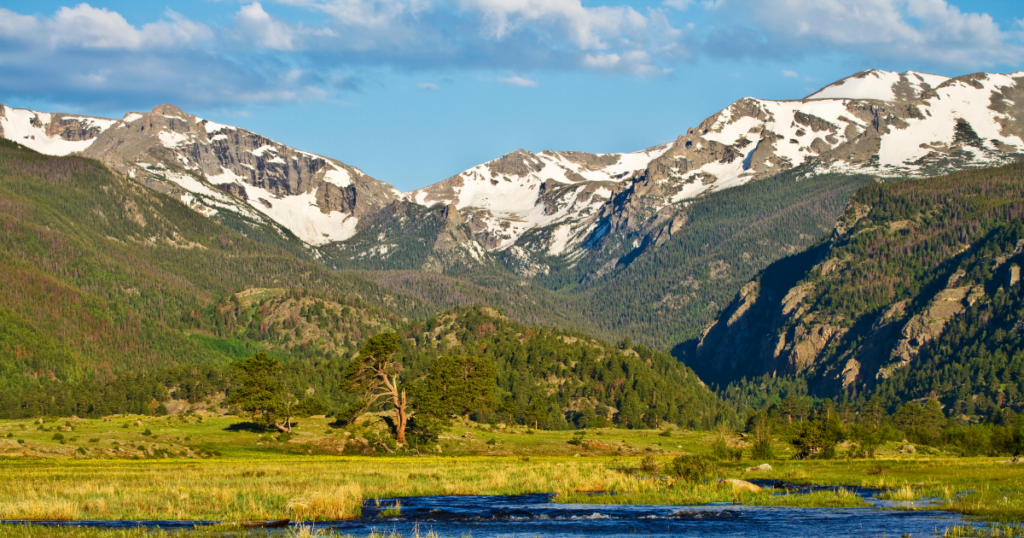
Overview of Rocky Mountain National Park
There are currently 417 national parks in the US, expanding over more than 84 million acres. Rocky Mountain National Park is one of the most popular ones because of its location and diverse ecosystems.
It encompasses 265,461 acres of federal land, in addition to 253,059 acres of US Forest Service wilderness.
It’s surrounded by the Roosevelt, the Routt, Arapaho national forests, and the Indian Peaks Wilderness area. The park contains 150 different lakes, more than 350 miles of trails, and rivers that extend for more than 450 miles.
RMNP is located about 76 miles away from Denver International airport, making it a great destination for all outdoor enthusiasts. It’s located between Estes Park and Grand Lake, within the Front Range of the Rocky Mountains.
Rocky Mountain National Park contains some of the highest peaks and elevations in the US, with heights ranging from 7,860 to 14,259 feet. It also includes the highest paved through road in the US. RMNP is home to 60 mountains that peak over 12,000 feet, in addition to a number of thirteener peaks that appeal to mountain climbing lovers.
History of RMNP
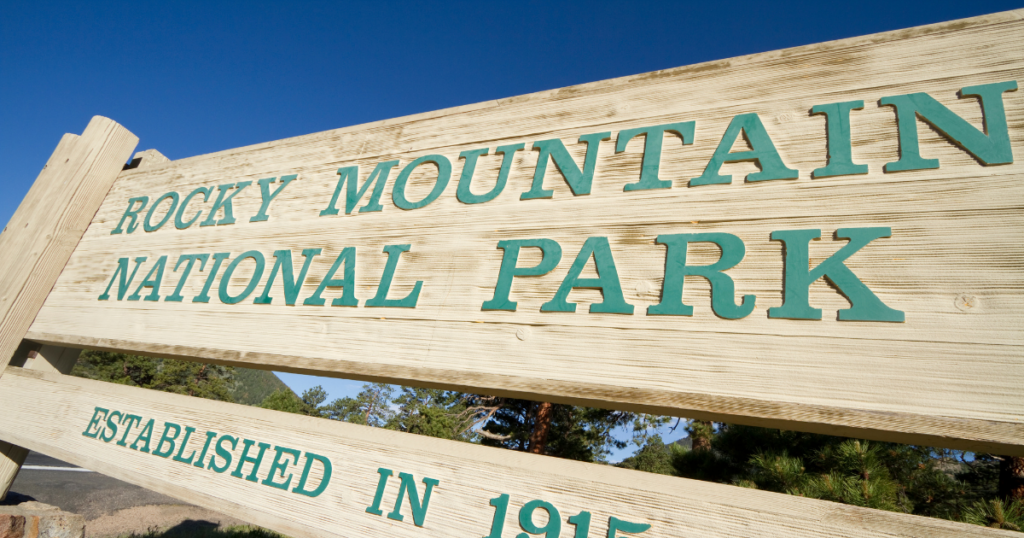
President Woodrow Wilson signed the Rocky Mountain National Park Act on the 26th of January, 1915, to preserve the boundaries of the park and protect and for future generations. In 1930, the Civilian Conservation Corps built Trail Ridge Road, and in 1976, UNESCO listed the park as one of the first World Biosphere Reserves, as an area that shows a balanced relationship between nature and people in a protected area.
But the history of the park started thousands of years earlier. The meadows and peaks of the park were shaped by the massive glaciers that make the area inhabitable.
About 11,000 years ago, early humans began to inhabit the valleys around the mountains. Hunting gear of the early native inhabitants was found in the area, but they don’t tell us much about how they made it their home.
The Ute people were among the earliest tribes that lived in the Great Basin and later settled in Colorado. Although they never made the area their permanent home, the Ute people ruled the area until the 1700s.
They settled on the western sides of the Rocky Mountains, usually following a hunter-gatherer lifestyle. The Ute people left several marks on the Ute trail that visitors can still see today.
In the 1800s, the US government acquired the land, and the area attracted a lot of miners. They built several settlements like Lulu City, where people caught several animals during summer and winter.
In the 1900s, this area began to attract tourists, as government officials called for the national conservation and preservation of nature for future generations. Enos Mills advocated for the creation of a new national park in the area, while people who worked in mining and logging were against the idea. Finally, in 1915, President Woodrow Wilson signed the Rocky Mountain National Park Act.
During this period, the park was surrounded by private landowners who accommodated guests in their lodges and cabins near Estes Park and lodges and also helped maintain the park, trails, and roads leading to it. After World War I, rangers built better trails and comfort stations.
During World War II, the number of visitors declined but started to boom again in the 1960s. On the park’s 50th birthday, a new visitor center was built, and visitors could watch movies or get help from the park’s guides.
During the 1970s, several laws and acts were approved to help maintain the park’s ecosystem and protect the different species that live in it. For example, campers were assigned backcountry sites where they can park and camp.
The park’s rangers educated visitors about how to preserve the plant and animal species. Today, law enforcement rangers, administrators, biologists, and resource specialists work with a lot of volunteers to manage and maintain RMNP.
Geographical Zones of the Rocky Mountain National Park
The Rocky Mountain National Park is divided into five main geographical zones. Each one contains special wildlife species and creates opportunities for a lot of exciting outdoor activities.
Moose and Big Meadows
This region is located to the western side and about 30 miles away from the Continental Divide. It contains several trails for those who are interested in studying grass and wildflowers, in addition to areas like Long Meadows, where you can go birdwatching in the summer and spring and cross-country skiing in winter.
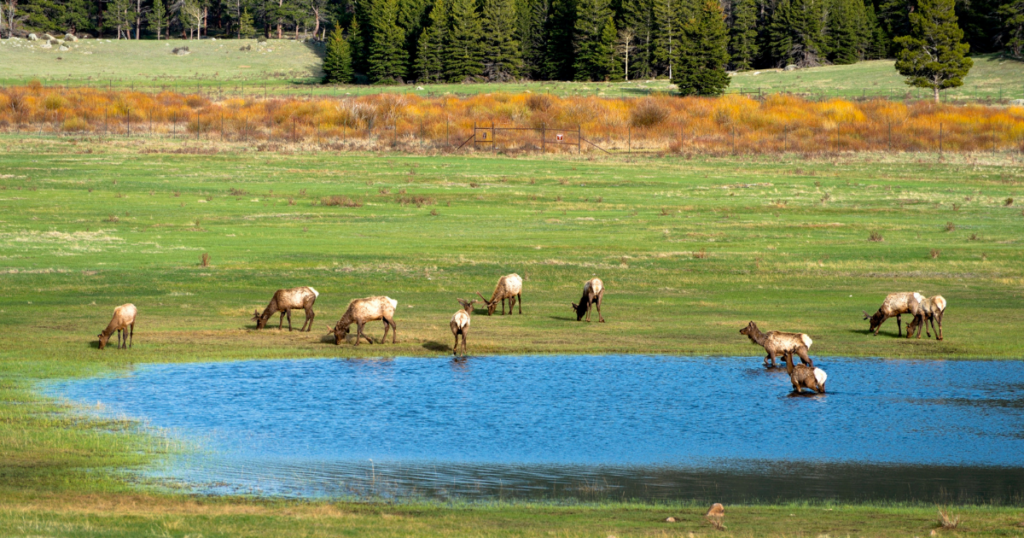
History lovers can explore the remains of Lulu City, an abandoned silver mining town. The valley trail contains about 39 mines in total and a historical wildfire observation tower.
Cascade Falls, Granite Falls, and Adam Falls are among the attractions in this region, in addition to the Lake of Clouds, Lake Verna, Lake Nanita, and Lake Nokoni.
Alpine Region
This region includes trails at high elevations, including the Chapin Pass Trail, which passes through the Chapin Creek valley. This is a great spot for those interested in wildflowers and hiking.
It contains other trails like the Tombstone Ridge and Ute Trail, both offering outstanding camping sites. Camping lovers can also visit Lake Irene, which is an excellent area for picnics.
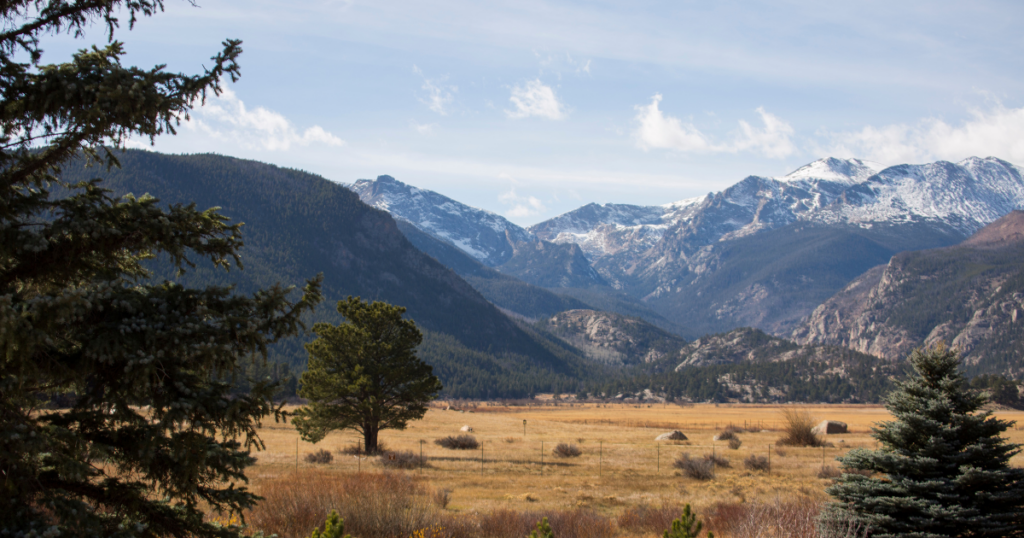
Wilderness
This region is located in the northern part of RMNP. It contains the Mummy Range, where the peaks are more forested than others in the parks, although some around the Mummy Mountain and the Ypsilon Mountain are glaciated. This region also includes the Alluvial Fan Trail, which leads to the site of the Lawn Lake Flood that took place in 1982.
Beaver lovers can encounter a lot of beavers at Cow Creek. Horseback riders can also explore the Beaver Mountain Loop, which passes through several meadows and forests and provides a great view of Longs Peak. During wintertime, the summit can be covered in snow that can be about 5 feet deep.
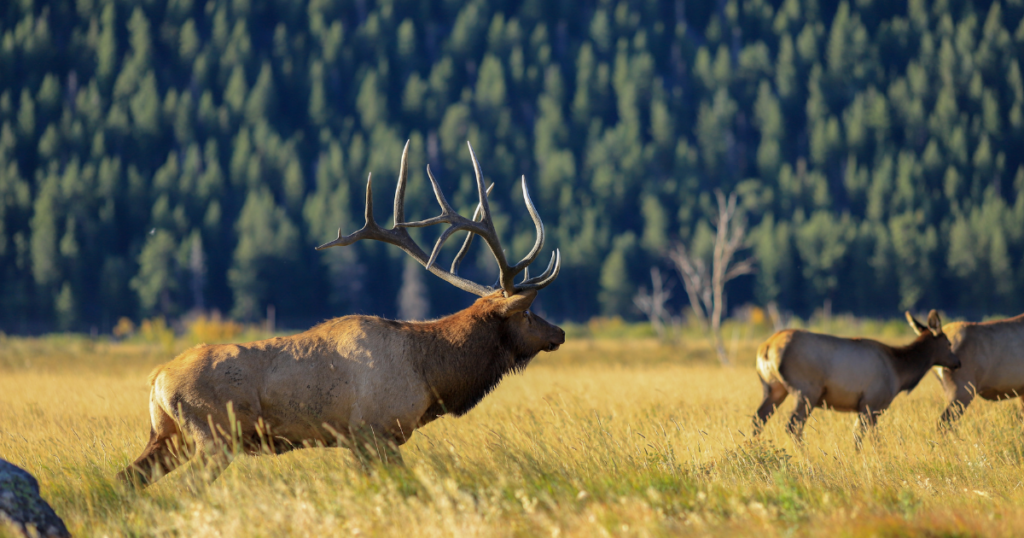
Birdwatchers, hikers, and bikers prefer to explore the trail to Lake Estes, which extends through a bird sanctuary into the lakeside picnic area. Visitors can also visit Crystal Lake, one of the deepest lakes in RMNP. Ecology lovers can also visit the granite domes of Lumpy Ridge, which have been sculpted by erosion to create balanced rocks and pillars around the trail that extends along the Estes Valley.
Heart of the Park
This region includes the most popular hiking trails and the greatest views. It includes Flattop Mountain that allows hikers to hike three climate zones on their way to Hallett Peak.
At the bottom of Flattop Mountain and Hallett Peak, visitors can visit Bear Lake, a high-elevation lake in a spruce and fir forest. They can also take a hike along Mill Creek to see the lumber and sawmill enterprises that operated in Hollowell Park.
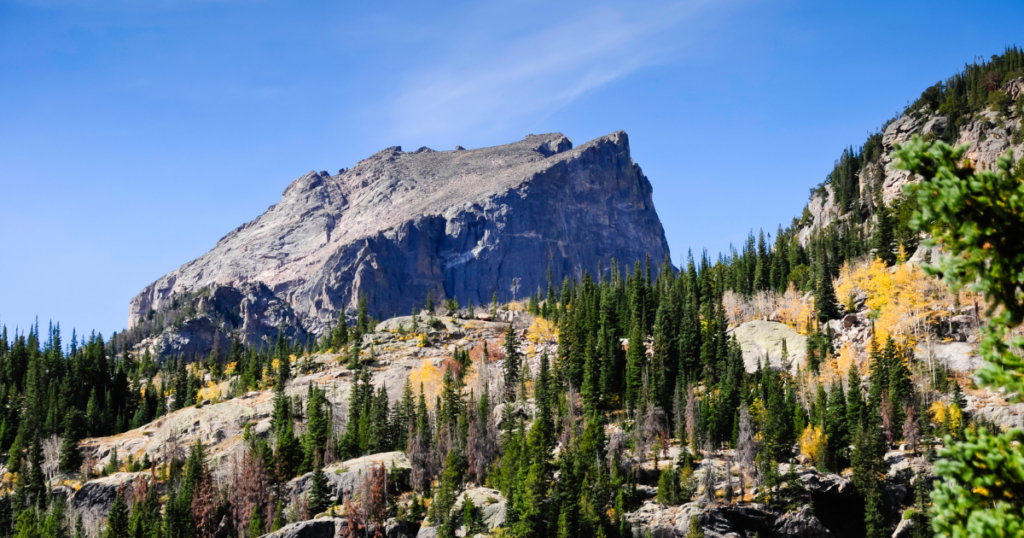
In this region, birdwatchers can study different species around Sprague Lake. Hikers and campers can also enjoy their time at the Glacier Basin campground.
Wildlife and nature photographers love to take photos of Dream Lake, especially during winter. At a short hiking distance, Emerald Lake and Lake Haiyaha are located, surrounded by boulders set up by the ancient inhabitants of the region. In addition, the region includes other lakes like Nymph Lake, Two Rivers Lake, Odessa Lake, and Bear Lake.
Those interested in water hiking can visit The Pool, a water pocket located where Spruce and Fern Creeks join the Big Thompson River. Along the gravel road, hikers can watch the beaver-cut aspen, the Arch Rocks, and the frozen waterfalls in the winter.
Waterfalls and Backcountry
This region is famous for Longs Peak, the park’s fourteener. It’s located south of Estes Park and includes the Wild Basin area, as well as other peaks like Twin Sisters, Boulder-Grand Pass, and Granite Pass.
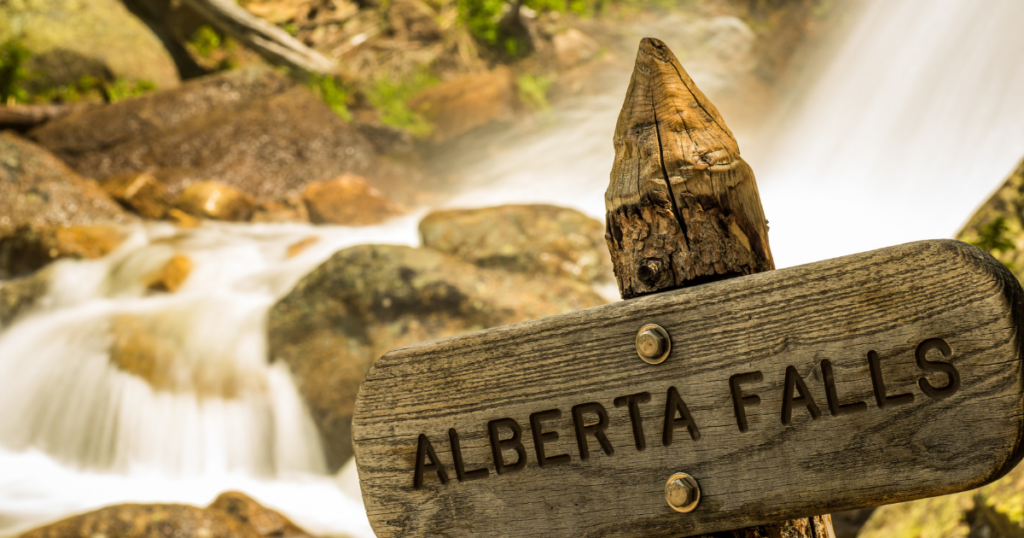
When you visit this region, you can visit the Eugenia Mine, which operated in the late 19th century, and see the old mining equipment. You can also enjoy walking in this region during spring and summer to see the wildflowers. In addition, the region is famous for several lakes and waterfalls with adjacent campsites where you can go camping with your friends and family.
Natural Features and Ecosystems of the Rocky Mountain National Park
The ancient glaciers and Continental Divide carved the topography of the park into several ecosystems. Several ecological systems exist near each other because of the variety of elevation that also provides numerous breath-taking sceneries.
Montane Ecosystem
The Montane ecosystem exists at elevations between 5,600 and 9,500 feet, creating a rich ecosystem of meadow valleys and slopes that support a rich collection of plant and animal life. The rivers and open meadows are covered by wildflowers in the spring and summer, making it the perfect spot for picnics and all-day-long strolls with the family.
Plant and flower lovers love taking photos of the slopes that surround the meadows, as they’re home to several tree species. The Ponderosa Pines are scattered around the south-facing slopes of the Montane, with spaces between the trees because of the difference in soil moisture.
Where the soil is too dry, grass, herbs, and shrubs cover the area. The old pines release a pleasant smell as the bark changes to red, so spending time in this area will be an enjoyable experience.
On the north-facing slopes, the soil is moist, and the trees grow closer to each other. You can find Douglas Fir, Engelmann Spruce, Lodgepole Pine, and More Ponderosa Pine trees.
The high moisture soil also supports the growth of Quaking Aspen with its easy-to-recognize white bark. Along the streams, water-loving Willows and Birch grow to provide shelter for the animals and birds that live near the water bodies.
Visitors can spend their time at Moraine Park or at Horseshoe Park, both located on the eastern side of the Rocky Mountains. On the western side, fishing enthusiasts usually spend their time in the Kawuneeche Valley.
The Montane ecosystem is home to several types of wildflowers like the Mountain Iris, Colorado Columbine that grows in the shaded regions, and the Horsemint that grows in clusters in the sunny areas of the meadows.
The Blanket Flower and Western Wallflower also grow in the sunny areas, while the Golden Banner prefers to grow around streams. These different types of flowers attract kids and adults who take pictures of them and enjoy family picnics around them.
Birdwatchers also find the Montane ecosystem quite inviting. It’s home to several bird species that live in harmony and can be found at different times of the year. The Downy and Hairy woodpeckers can be seen excavating old trees to look for larvae. Other colorful birds like the Cassin’s Finch, Mountain Bluebird, and Western Tanager can be found in different parts of the region. The meadows and slopes are also home to birds of prey like the Great Horned Owl and Golden Eagle.
Animal lovers are expected to encounter some interesting animals like squirrels, chipmunks, badgers, voles, bobcats, in addition to the Montane shrew, mule deer, and elk. Most of these animals, like the mule deer, play a significant role in the food chain as they’re the primary prey of mountain lions, which can also be seen around the slopes of the region.
Subalpine Ecosystem
Between elevations of 9,000 and 11,000 feet, the Subalpine ecosystem occupies forests and lakes that support fantastic wildlife species. Evergreen trees cover the mountainsides of the Subalpine areas, mostly consisting of Subalpine Fir and Engelmann Spruce. After wildfires, the areas might witness the occasional growth of Lodgepole Pines.
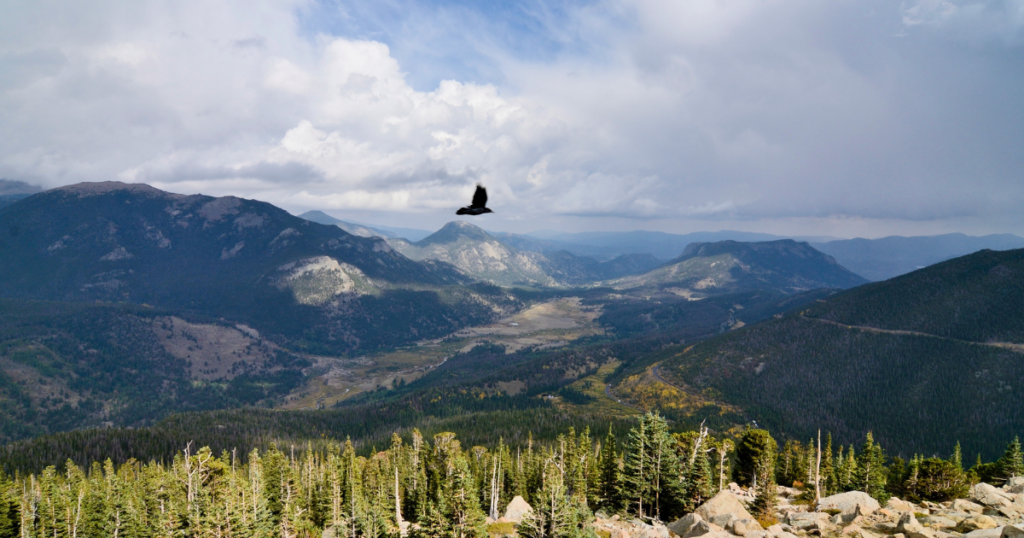
At higher elevations, the fir and spruce trees become shorter because of the strong dry winds. They also encourage growth on one side of the tree, which is known as banner trees, and can be found in several areas of the Subalpine ecosystem.
At the treeline, the rocks provide wind protection, allowing the trees to grow more horizontally than vertically. Additional growth happens where the branches contact the soil, resulting in the low growth of dense trees. These trees are known as the Krummholz trees and can be hundreds or even thousands of years old.
Several meadow flowers grow in these areas, like the Spotted Coralroot, which is common to find in the lower Subalpine forests. The Shooting Star can be found in wet areas that extend from the Montane to the Alpine regions.
Birds like the Blue Grouse, Gray Jay, Northern Goshawk, and Ruby-Crowned Kinglet can be seen during the warm season. You can also see several animals like the Nuttall’s Cottontail, Snowshoe Hare, and Chickaree squirrel, along with some of the predators like the mountain lion, coyote, and black bear.
Alpine Tundra Ecosystem
The Alpine Tundra starts between the elevations of 11, 000 and 11,500 feet. It’s often referred to as the land above the trees. You can reach these areas through Trail Ridge Road.
Almost one-third of the RMNP belongs to this treeless, cold, and relatively dry ecosystem. This ecosystem is characterized by cold temperatures, shorter growing seasons, and longer winters. The shift or transition zone between the Subalpine and Alpine zones is called the treeline.

Because of the strong winds, most plants are perennials and dwarfed. Cushion plants grow abundantly, as they’re protected from the wind that blows above them. Some flowers like Snow-Lily, Snow Buttercup, Alpine Avens, and Western Yellow Paintbrush grow in the short summer. Most of these flowers have hairs on the stems and leaves to provide good wind protection.
Snow is prominent well into June, and the temperature reaches its highest in July. But even during July and August, visitors can expect rain, lightning storms, and winds that blow at speeds between 20.2 and 79 miles per hour.
Because of the nature of these areas, the exposed soil can be easily blown away due to repetitive hiking and trekking activities. It’s required to stick to the designated trails to help protect the Alpine Tundra plants.
Plants grow short and only have a short window in the summer to flower and produce seeds, while lichens stick to the exposed areas of the rocks. Animals that live in these areas developed special adaptation techniques to be able to survive the long, harsh winters.
The Yellow-Bellied Marmot eats a lot during the summer and hibernates in winter until the food is abundant, while the American Pika collects food and stores it to be eaten in winter. Some animals like the Bighorn Sheep are well suited for life at this high elevation, as their hooves help them climb the rocky slopes. Others like the elk will only visit these regions during the summer months.
Fewer birds can be seen at these high elevations, including the Common Raven, Prairie Falcon, and Rosy-Finch. Wildlife lovers can also see different animals like the Golden-Mantled Ground Squirrel, Pocket Gopher, Red Fox, in addition to several predators like bobcats, coyotes, and mountain lions.
In the past, Native Americans explored these areas to catch animals and find plants that were crucial for their survival, and the Ute Trail holds strong evidence of how they traveled across the mountains. In 1932, the Trail Ridge Road was completed to allow the park’s visitors to explore the Alpine Tundra areas.
The Trail Ridge Road is only open from Memorial Day Weekend to mid-October. When closed, visitors can still access the region on foot or skis. The Alpine Visitor Center, located along Trail Ridge Road at 11,796 feet, provides valuable insights into what visitors can experience on their hiking trips.
Glaciers
Glaciers are common in different parts of the Rocky Mountain National Park and are characterized by the large masses of moving ice that carve their way through rocks. Signs of giant glaciers can be seen all around the park at the highest elevations.
A glacier is a mass of ice or snow that is heavy enough to flow. The new snow compresses the old, transforming it into dense ice. The ice in the accumulation zone flows down to lands at lower altitudes.
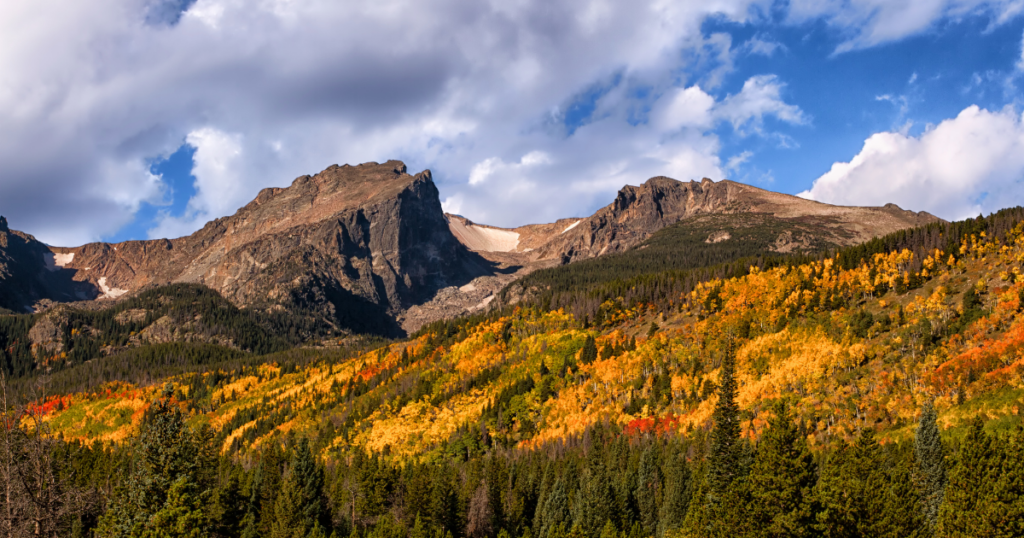
As glaciers move, they leave lines along their sides, which are like beach lines to indicate the highest level of the glacier’s extension. As time passes, these rocks start to get covered by different types of vegetation.
All the glaciers of the Rocky Mountain National Park are cirque glaciers, which are small glaciers that occupy a bowl-shaped basin. In the past, Forest Canyon, Chaos Canyon, and Loch Vale were valley glaciers that are no longer filled with ice.
Riparian Ecosystem
The Riparian ecosystem runs through the Montane, Subalpine, and Alpine Tundra zones to support life for the plant, bird, and animal species that live next to water bodies. The RMNP contains several rivers, including the Colorado River on the west side, and the Cache La Poudre, Fall, and Big Thompson rivers on the east side.
Many climatic variables like temperature and elevation affect life in the Riparian ecosystem. Due to the difference in temperature and precipitation, there is a big diversity in the type of plants and animals that can be found in the Riparian zones.
History of Wildland Fires in Rocky Mountain National Park
Despite being destructive, wildfires play an essential role in many environments. They represent nature’s way of getting rid of forest litter and making way for healthy nutrients to get back into the soil to support new plants and animals.
However, when fires burn too long, they can wipe out ecological communities, and the ecosystem might never recover. For example, a study was conducted in the conifer forests of the RMNP to study the effects of 52 wildfires that occurred between 1988 and 2011.
Compared to areas that suffered from older wildfires, the new areas experienced no regrowth because of the increasing temperatures and continuous drought. Climate change might cause ecosystems and landscapes to change from forests to grasslands. Even if the trees grow back, the area might experience the growth of new tree species that are better suited for the hot, dry weather.
There were several acts that enforced laws against leaving fires in any campsite or hiking spot, as the fire might spread to other regions in the park. There were other laws that restricted camping to specific locations to limit the spread of fires if they ever occur.
Wildland firefighting has evolved over the years to help maintain the park. When the national park was first established, superintendents focused on preventing and controlling all types of wildfires. These efforts helped protect the park but were never enough because wildfires happened for several reasons.
In the 1960s, ecologists and biologists studied wildfires and passed the Wilderness Act of 1964, which would allow wildland fires to burn if they were not threatening to people or communities as they would help restore the ecosystems. Today, new technologies help firefighters contain the fire within the park’s boundaries.
Why Do Wildfires happen in the Rocky Mountain National Park?
Today wildland fires are mainly caused by lightning. These only burn a few acres and either extinguish naturally or are put out by the firefighters. However, in some cases, lighting can cause big fires that spread for long distances and require more effort to be put out. These fires can also impact surrounding communities.
Although not common, negligence can also lead to the spread of wildfires. Some people accidentally or deliberately use substances that can cause wildland fires. Fuel used in camping equipment can be disposed of wrongfully and eventually cause fires that are difficult to control.
Famous Wildfires in the Rocky Mountain National Park
Throughout the years, some wildfires impacted the ecosystem of the RMNP.
Bear Lake Fire
This huge fire happened in 1900 due to the negligence of some park visitors who were trying to make a pot of coffee. After trying to put out their campfire, one of the logs kept on burning.
The wind picked up the burning log, and the fire spread to the nearby dry grass, starting one of the most massive wildfires in the park. The Bear Lake Fire is also known as the Big Fire and continued burning for more than two months before it was finally put under control.
Ouzel Fire
Lightning caused the Ouzel Fire to start in 1978. At this time, the rangers allowed the fire to burn under monitoring, as it was behaving as expected. However, the strong winds caused the fire to spread quickly.
After one month, some rain and snow helped the firefighters put out some of the fire, but later the strong winds pushed it again towards the east. Eventually, they managed to put it out before escaping the park’s boundaries.
Fern Lake Fire
An illegal campfire set up in the Forest Canyon caused this huge fire to spread in 2012. It was evident that the fire was going to be difficult to control because of the strong winds and steep terrain.
Because of the dead trees, fighting the fire from the ground was very challenging. Due to inaccessibility, this was the first fire in the Forest Canyon for at least 800 years. In one incident, the fire spread for more than 3 miles in less than 35 minutes, prompting rangers to issue evacuation orders of nearby communities.
A snowstorm helped the firefighters put the fire under control after spreading for more than 3,500 acres. The firefighters finally managed to stop it near Bear Lake Road before spreading outside the park.
Top Things to Do In the Rocky Mountain National Park
The Rocky Mountain National Park is full of trails, lakes, waterfalls, wildlife areas, and scenic drive routes that create amazing opportunities for outdoor fun. If you’re visiting the park for the first time, there are a few activities that you don’t want to miss. Check out these ideas and tips on how to enjoy your time at the RMNP.
1. Drive through the Trail Ridge Road
Between Memorial Day Weekend and mid-October, driving through Trail Ridge Road will be an activity you don’t want to miss. It’s the highest paved road in the US and takes you to the higher elevations where you can study the plants and animals or enjoy a hike.
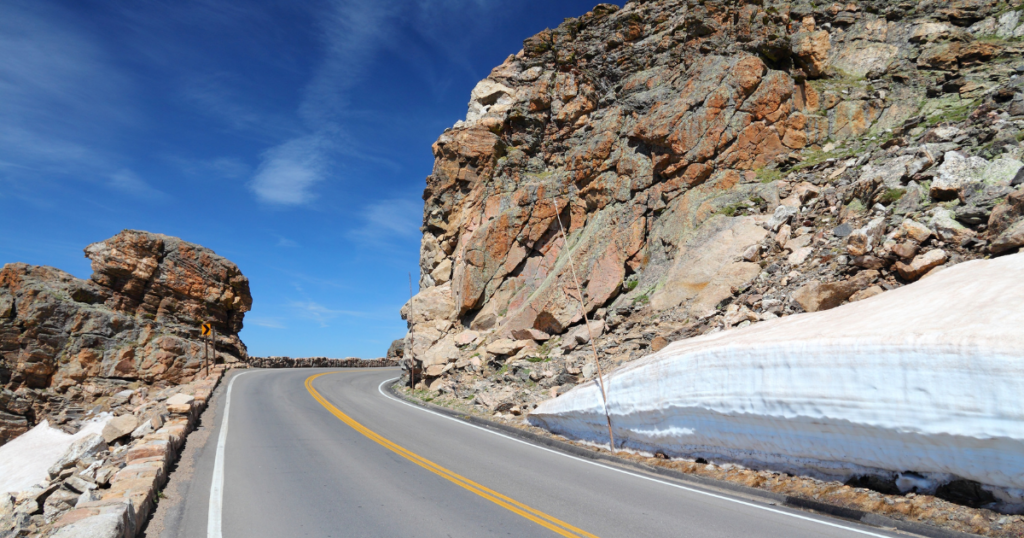
The trial runs from Estes Park in the east to Grand Lake in the west. It extends for 48 miles, 11 miles of which are located above the treeline in the Alpine Tundra. It crosses the Continental Divide and reaches its highest point at 12,183 feet. As you elevate, the temperature drops drastically, and there’s a big chance for rain and strong winds even in the summer.
Along the drive, you can take photos of the wildlife scenery and even stop the car to enjoy a short hike. You can also visit the Alpine Visitor Center to learn more about the history of the park and the activities that you can enjoy.
2. Enjoy the Panoramic Views of the Forest Canyon
The Forest Canyon Overlook is one of the best overlooks along Trail Ridge Road. You can see views of several peaks like Longs and Stones Peak, as well as Gorge Lake.
This is a great chance for those who like to take landscape photos. The beauty of nature can bring a lot of serenity to kids and adults who can see different parts of the park. If you enjoy painting, you might be able to draw a landscape scene if you manage to handle the cold temperature.
3. Go On a Hike
With more than 350 miles of hiking trails, hikers can spend weeks exploring the different trails that run through the Rocky Mountain National Park. These trails range in difficulty level from those that work for beginner hikers to the more challenging ones.
The trails around the lakes are suitable for short strolls with family and friends. For more serious hikers, the ridgeline trails represent a great chance to enjoy the view and the different ecological zones.
- The Alpine Ridge Trail next to the Alpine Visitor Center is a short yet easy trail that takes you to a spot where you can enjoy the panoramic views of the Rocky Mountains.
- The Ute Trail is a moderate trail that extends for 4 miles and has a historical value, as it follows the route the Native Americans followed to access different parts of the park.
- The Deer Mountain Trail is a moderate trail that provides an excellent opportunity for those who enjoy summit hikes. It provides a great view over Moraine Park.
- Sky Pond Trail is a strenuous hiking trail that you can explore to enjoy the high mountain views, lakes, waterfalls, and stream crossings.
- Hallett Peak Trail is another strenuous trail that starts at Bear Lake and takes you on a trip to the summit of Hallett Peak.
- Long Peak Trail is one of the most difficult trails and extends for 15 miles. At the height of more than 14,000 feet, you will enjoy the overviews of the surrounding summits. The Keyhole Route is only suitable for the most experienced hikers due to the risk of exposure.
If you’re attempting to explore one of the high-elevation trails, it’s recommended that you take a few days to get your body accustomed to the altitude. You can start hiking on one of the lower trails, like the Bear Lake Trail, then explore one of the higher ones.
4. Visit Alberta Falls
Views of the Alberta Waterfalls can be explored from different angles. A 1.7-mile hike can start from the Glacier Gorge parking lot, and then you can go on an uphill walk to the waterfall. There are multiple trails along Glacier Creek that allow you to take different photos of the waterfall.
5. Enjoy a Picnic By a Lake
There are multiple streams, rivers, and lakes scattered around the park. Some of these lakes represent a cool location for a family picnic, while others are suitable for fishing enthusiasts.
The lakes are also surrounded by multiple hiking trails that range from easy to challenging. For families with younger kids or those who don’t like to do a lot of hiking, spending time around Bear Lake would be perfect.
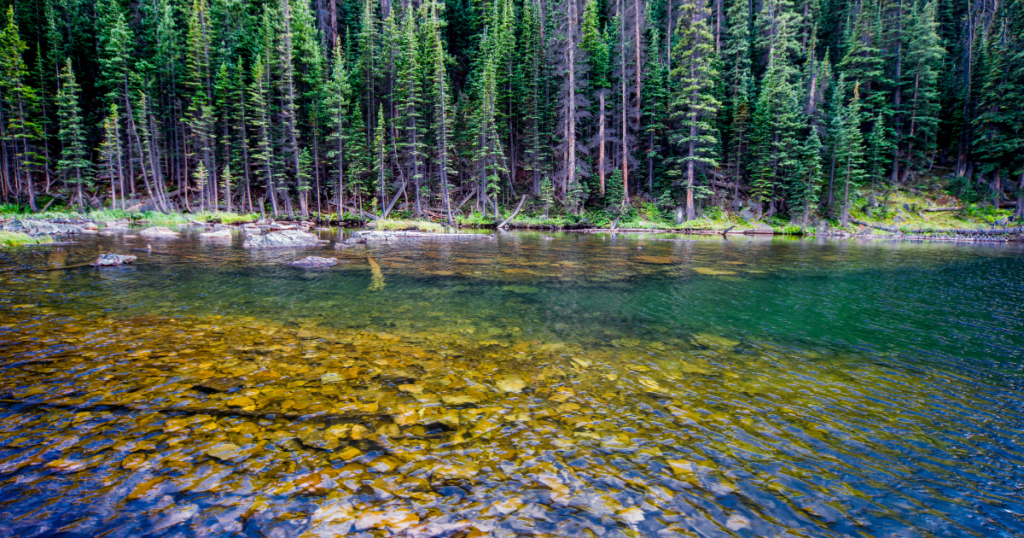
Families with older kids or hiking lovers can explore the area around Dream and Emerald Lakes. More experienced hikers and those who are used to the elevation will enjoy spending time around the Sky Pond.
6. Spend Time at Moraine Park
Wildlife lovers can enjoy their time at Moraine Park, where they can watch herds of elk and groups of birds roaming the valley. This is a great chance to take photos of animals, study plants, and watch the birds.
There are also lots of hiking trails that can be found around Moraine Park. They’re suitable for first-time hikers and groups.
7. Go Rock Climbing
Rock climbing and mountaineering lovers can find numerous peaks to explore. From 12,000 to 13,000 and even 14,000 peaks, the Rocky Mountain National Park attracts climbers from different parts of the world.
Beginner climbers can explore with easy climbs and bouldering, while more experienced climbers can engage in multi-day climbing trips that go up the vertical cliffs. Ice climbing is also popular in the winter.
8. Go Cross-Country Skiing
Cross-country skiing and snowshoeing are popular activities that you can try in the winter. Since some of the hiking trails become inaccessible in the winter months, these two enjoyable activities can provide lots of fun when the temperature drops.
Most of the hiking trails are accessible by snowshoe, so you can explore the parks and trails that exist at lower altitudes. The Subalpine and Alpine Tundra regions can be explored by cross-country skiing. Both activities can be arranged with the help of a ranger, who designs a program based on your preferences and experience level.
Visiting the park during the winter months is fun but can be dangerous. Avalanches are expected during the winter months, so you should visit the park’s service website to check for any updates on the weather conditions and the possibility of avalanches.
When Is the Best Time to Visit Rocky Mountain National Park?
In 2020, about 3.31 million people visited the Rocky Mountain National Park, which makes it one of the most popular destinations for wildlife and nature lovers. Picking the right time to visit the park will have a huge impact on the success of your trip. There are a few things that you need to think about before planning your trip.
- Think about where exactly you want to go. Some of the roads and trails can be closed because of the snowfall.
- Understand that because the RMNP is a large park, the weather can differ drastically from one zone to another. Moreover, if you’re going hiking or climbing up a trail, the elevation can make the weather change a lot during the same day.
- Consider the crowded times. Summer is typically more crowded than winter, while fall weekends can also be crowded if you’re planning to hike or camp.
- Make a list of the activities you plan on doing. There are lots of activities to do at the Rocky Mountain National Park, but you can’t do all of them in one go.
Because of these factors, there are several times of the year that you can pick depending on your preferences and planned activities.
Best Time for Hiking
Hiking enthusiasts can go hiking in the RMNP in the spring, summer, and fall, depending on the trails and their elevation. Snow can still be present at higher elevations throughout June, and this means that you should dress and pack for a winter hiking trip, although it’s officially summer.
Thanks to the huge number of hiking trails available, every hiker will find the perfect hiking trail, regardless of their level of experience. Some trails are only suitable for experienced hikers because they can be too challenging.
Take a look at the trail conditions to make sure that it’s open and safe. Cross-country skiing, snowshoeing, and hiking with traction devices can be great alternatives.
Best Time for Backpacking
Backpacking, especially at higher elevations, will be the perfect summer activity. After June, the snow melts, which creates an excellent opportunity for backpacking across the park.
Trips to the high country are extremely successful because you won’t be challenged by the cold weather. During the daytime, the weather will be warm and sunny, and it will be chilly at night, so you can sleep outside. Summer is the busiest time for backpacking, so you might not be able to get all the permits needed for your trips unless you plan your backpacking adventure in advance.
Best Time for Birdwatching and Wildlife Viewing
Spring is the best season to see the birds and animals in the Rocky Mountain National Park because it’s the birthing season for most species. During the summer and fall, you can see large and small mammals, as well as colorful birds, across different zones of the park.
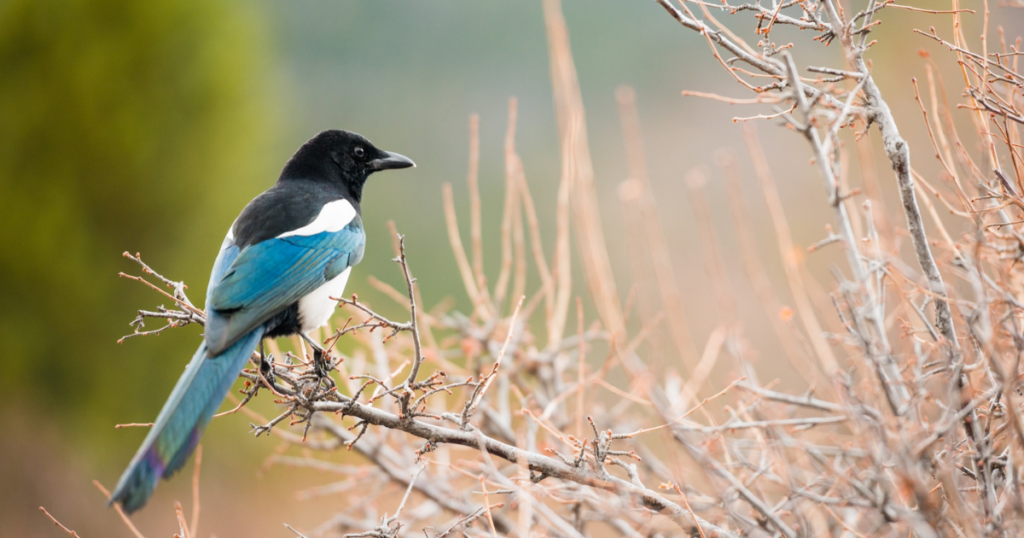
As the fall approaches, birds start to hide while larger mammals become more common to see in the open meadows. You can see mule deer gathering around each other or elks gathered in one area for the mating season.
Whether you choose to visit the park during spring, summer, or fall, you’ll have an excellent chance to take amazing wildlife photos of the creatures that live in the park. You need to pack the right photography gear and learn how to adjust the light to take better photos in all light and weather conditions.
Best Time For Rock Climbing
Rock climbing can be done throughout the year, although it’s best done during late spring and summer. Most of the climbing trails are closed during the winter and early spring, which is the nesting season of raptors.
Snow might still be present at the highest elevations, although it might start to melt by mid-summer to make rock climbing more fun. However, as a rock climbing enthusiast, you need to know that the weather changes drastically while you’re elevating. This means that you can easily experience winter weather during the hottest month of the year.
Best Time for Fishing
The lakes, streams, and rivers of the RMNP are home to several fish species that you can catch during different seasons. Although some fishing enthusiasts prefer to go fishing in the summer, most of them choose to go fishing in the fall.
During the fall, the park becomes less crowded, and finding a good fishing spot becomes easier. Greenback Cutthroat, Rainbow, Brook, and Brown Trout are common in The Loch, which is perfect for calm water fishing, allowing anglers to catch large amounts of trout.
Sprague Lake is another popular fishing spot, especially if you’re fishing with your kids. The side ponds and streams are perfect for beginner anglers.
Lawn and Crystal Lakes are suitable for hikers who are interested in fly-fishing in the most challenging settings. These spots work for hikers, who might also be interested in fishing in the Roaring River.
Despite being previously listed as endangered, Colorado State managed to restore the number of the Greenback Cutthroat Trout. Today, you can find it abundantly in several spots across the RMNP, including Baker Creek, Onahu Creek, Black Lake, Caddis Lake, and Loomis Lake. Most Greenback Cutthroat Trout are caught according to the catch and release regulations.
In other lakes and streams, you can keep some of the Brook Trout you catch. If you want to keep your fish, you can start fishing at Ouzel Lake.
Because of the elevation, the fishing season is very short in the RMNP compared to other national parks in the US. You need to apply for a Colorado fishing license if you’re over the age of 16.
Best Time to Avoid the Crowds
The least crowded time of the year is between November and April. The park becomes extremely crowded during the summer and throughout the fall weekends because the weather is warm and allows for multiple activities. But with a little planning, you can still avoid the crowds.
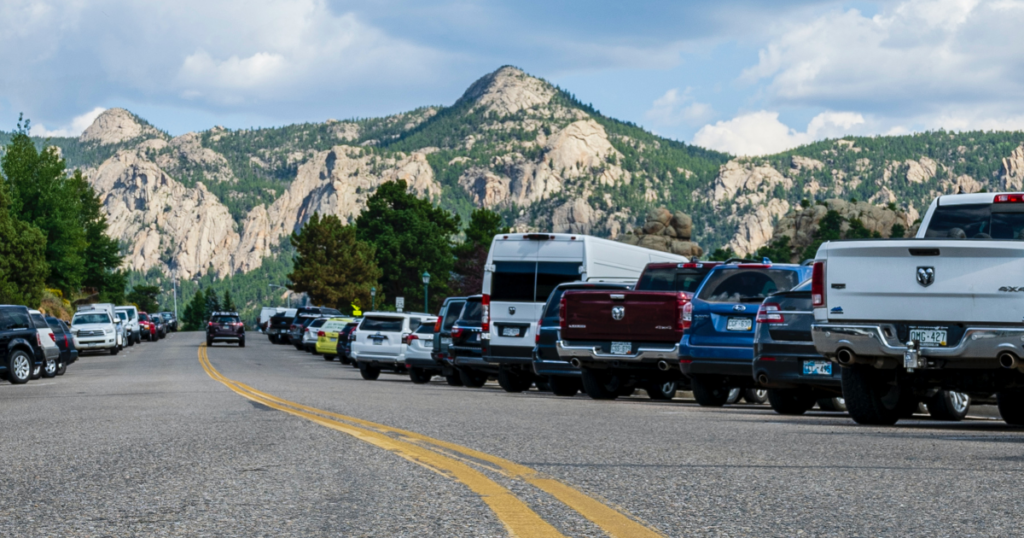
The more you hike and get away from the main trails, the less crowded the park will be. The east side is typically more crowded, so you might need to explore the west side to enjoy your time.
During the winter season, the park offers a different experience and is definitely less crowded. It becomes an amazing spot for winter outdoor activities.
How Much Time Do You Need in Rocky Mountain National Park?
Some people visit the park on every vacation because there are tens of activities to explore and try. However, if you’re visiting the park for the first time, you might need between 3 and 5 days to explore most of it and get a glimpse of what it can offer.
This period is enough to help you decide on the best spots that you need to focus on, and you can also explore some of the hiking trails. Most hikers who want to explore trails that exist at a higher altitude spend at least 5 days in the park. This time gives their bodies the chance to adjust to the elevation, so they can later engage in more strenuous and more challenging hikes.
Wrap Up
The Rocky Mountain National Park is an excellent destination for people of all ages and interests. It’s the perfect spot for a family picnic, introducing your kid to wildlife, a group of friends, or a solo hiker who likes to explore nature. Planning your trip and following the rules of the park will help you enjoy your time to the maximum. Thanks to the variety of activities, you will definitely find one that works for you.


